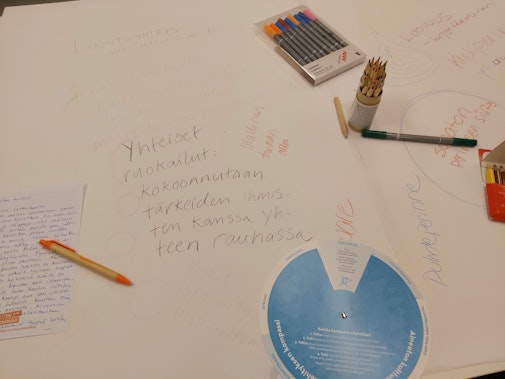Kansalaisfoorumi
Exploring Intangible Cultural Heritage through Literary Arts—A Transformative Pilot Project
In our pilot project, we explored intangible cultural heritage using the tools of literary arts, led by literary art educator Timo Harju. The process drew inspiration from the communal spirit and traditions of Kaustinen fiddle playing, showcased by heritage expert Olli Seikkula. The pilot process consisted of hands-on workshops, virtual clinics for personalized guidance, and a final celebration, all designed to deepen participants’ engagement with and understanding of intangible cultural heritage.
The pilot process activities ranged from creating tradition-themed mind maps to writing exercises that employed all five senses, enabling participants to vividly share and reflect on their cultural experiences. In the Finnish art education field, the term “literary art” differs from creative writing and bibliotherapy, often aiming for both skill improvement and emotional well-being, facilitated through the exploration of language as a tool and shaper of realities.

The pilot process included several types of writing exercises and other methods:
- Self-Introduction through Trees: Participants describe themselves as a type of tree and its growing location, using this as a metaphor for their roots and connections to cultural heritage.
- Mind Mapping: In pairs, participants create mind maps about intangible cultural heritage, deepened by thought-provoking questions from The Wheelchart of Sustainability and ICH to explore traditions more fully.
- Space for Ongoing Discussions: Emphasizes the critical role of conversation in sharing, understanding, and reflecting on intangible cultural heritage.
- Sensory Writing about Traditions: Writing about a moment within a tradition using all five senses to create a vivid, immersive memory.
- Music-Inspired Writing: Listening to traditional Kaustinen violin music and writing about the imagery and places it evokes.
- Virtual Clinics: Zoom meetings where participants propose and receive feedback on creative projects related to traditions they wish to explore.
- Heritage Potluck: A sharing session where participants bring items related to cultural heritage and discuss them, inspired by facilitator-led questions.
- Personifying Shame: Writing creatively about shame as if it were an animal, exploring its characteristics and behaviors.
- Object Monologues: Giving voice to a cultural object, allowing it to express its views on the traditions and people associated with it.

These exercises were designed to foster a deep, personal engagement with cultural heritage, encouraging participants to reflect, share, and learn from each other’s experiences and perspectives.
All in all, the pilot was a rich learning experience for everyone involved. We discovered that the literary arts are a powerful tool for safeguarding cultural heritage, promoting deep, transformative learning about personal and collective identities.




